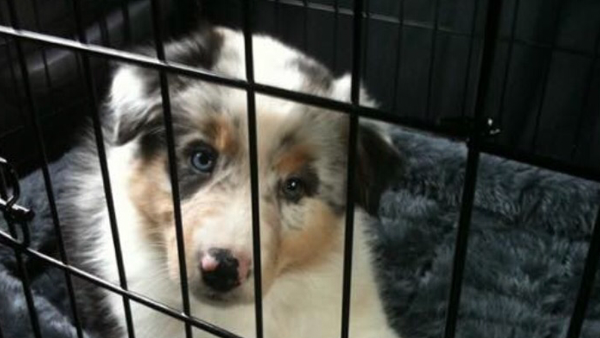CRATE TRAINING
Why use a crate?
- A crate is a safe, secure area for your puppy to be, when you can’t give him your full attention.
- It can help speed-up house training.
- It’s somewhere for your puppy to go when he needs time out.
- It’s a secure den for your puppy to retreat to, safe in the knowledge that he can relax and won’t be disturbed. (You should ensure children and other pets leave puppy alone when he is in it.).
- It’s the perfect way to protect your house from damage, due to inappropriate chewing!
- A safe secure way to transport your puppy and keep your car clean!
- Acclimatises your puppy to a crate for visits to vets or groomers.
- Ideal to use for those breaks away, it’s familiar to puppy and the holiday home is safe from your puppy!
How big should the crate be and where should it be?
- The crate should be big enough for your puppy to fit in comfortably when he is fully grown, room to stretch out and have a water bowl and interactive toys in.
- You need to place it in a convenient, but quieter part of the house, so puppy can still see and hear what’s going on, but is able to relax as well.
- Also a good idea to have it reasonably near an exit to the garden, for quick access, or carry him out to the garden in the early stages to save any accidents.
Introducing the crate
- The crate needs to be as comfortable and inviting as possible for your puppy to build up positive associations with it. Put a soft towel or vet bed in the base, both easily cleaned. Always have fresh water available and place a couple of safe toys in the crate; a stuffed Kong is useful.
- Put some newspaper in the base, separate from the vet bed (half and half if possible). If your puppy does need to toilet and cannot attract your attention, he will not want to go on the vet bed, but will probably have used newspaper for this purpose before he joined your family. Change this paper each time it is soiled (wait until your puppy is away from the crate, do not comment or criticise the puppy for using the paper. He has to go somewhere if you are not available to let him out).
- Initially leave the crate door open so the puppy is free to come and go, use tasty food treats to encourage him – start with them near the door and gradually move them further back once he is happy entering. You can introduce a word such as kennel or bed at this stage, so that he can begin to associate the word with the action!
- Do not rush this stage – if your puppy is not happy to go into the crate, do not force him, that will set up bad associations. Take your time in ‘explaining’ to him that it is a safe and fun place. Most young puppies are very happy to go in the crate, especially if they have been used to spending time in a whelping box whilst with their littermates.
- Do this several times during the day. Feed him his meals in the crate. Stuff a Kong with tasty treats and put that towards the back of the crate, if he is comfortable at this stage, you can push the door to. Stay around at this stage and try to ignore what he is doing, so he doesn’t think it is a big deal.
- Depending on how comfortable your puppy is at the above stage, you can begin to close the door for short periods at a time. Always ensure puppy has been toileted before, so you know he won’t need to go out for a little while. It’s also a good idea to have a little game with him first, so he is tired. Again use a Kong or put his meal in with him.
- Begin to go about your day as normal with puppy confined. If he begins to whine or bark, remember to ignore him. Only go back to him when he is quiet. If you go back to him when he is being noisy, he will learn to keep barking for longer and longer periods until you return!
- As long as you are careful to ensure good positive associations with the crate, your puppy should quickly become happy to relax as soon as he enters the crate. Puppies quickly learn to sleep through the night in the crate and are usually clean very quick

